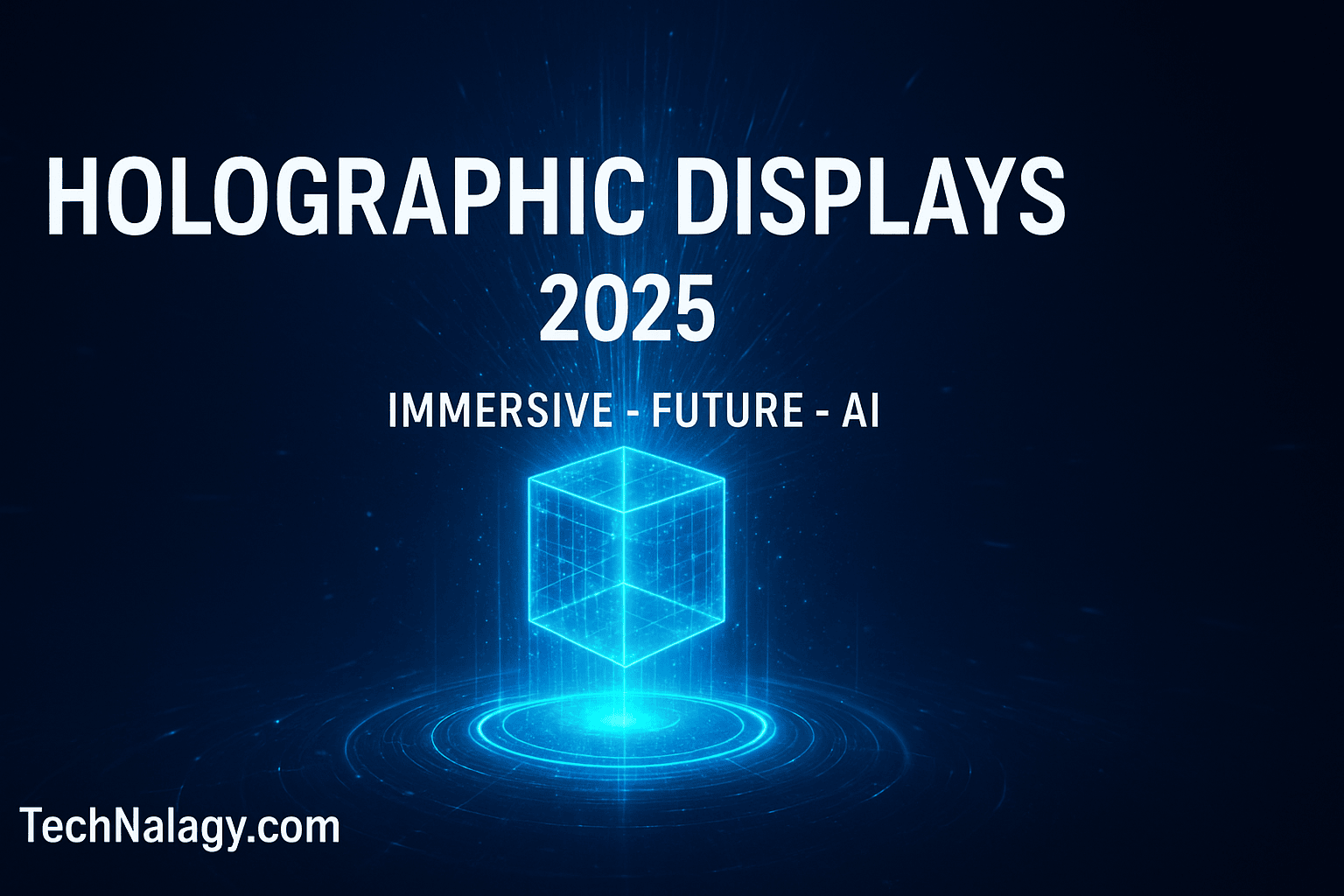Holographic Displays in 2025: The Next Evolution of Screens and Immersive Tech
Introduction
Screens have defined the digital age, but in 2025, the rise of holographic displays marks a dramatic leap forward. No longer confined to flat two-dimensional panels, holographic technology projects fully three-dimensional visuals that float in the air, interact with users, and transform how we experience digital content. From entertainment and healthcare to education and business, holograms are reshaping industries at a pace once reserved for science fiction.
But what exactly makes holographic displays so revolutionary? And how are they tied to broader trends like extended reality, spatial computing, and ambient intelligence? This article takes a deep dive into the next generation of display technology — its breakthroughs, use cases, challenges, and what lies ahead.
Table of Contents
What Are Holographic Displays?
At their core, holographic displays create light fields that allow users to perceive depth, motion, and interaction without special glasses. Unlike VR headsets or AR smart glasses, which rely on wearable devices, holographic screens project 3D images directly into the physical environment. This makes the experience both immersive and accessible to multiple people at once.
Engineers achieve this effect using diffraction, lasers, and advanced optics, enabling visuals to appear as though they exist in real space. With holograms, a medical student could examine a digital heart as if holding it in their hands, or a business team could collaborate around a floating prototype.
The Tech Revolution Behind Holograms
The progress of holographic displays in 2025 comes from advances in several interconnected technologies:
Light Field and Laser Projection
Modern holograms rely on light field displays that simulate how light bounces in real environments. Laser-based projectors enhance brightness and clarity, making holograms visible even in well-lit rooms.
Spatial Computing Integration
Holograms are no longer just visual illusions — they’re interactive. Through spatial computing, holograms respond to gestures, eye tracking, and environmental data. This allows people to manipulate holograms in the same way they interact with physical objects.
Extended Reality Ecosystem
Holograms don’t exist in isolation. They are closely tied to extended reality technologies, which blend digital and physical environments across VR, AR, and MR. Together, these systems create seamless immersive experiences.
AI-Powered Interactivity
Artificial intelligence powers real-time interactions, enabling holographic characters, tutors, or virtual assistants to respond naturally to users. In gaming, for example, AI allows holographic NPCs to move, react, and adapt in ways that feel lifelike.
Ambient Intelligence
In the smart homes and workplaces of tomorrow, holographic displays will integrate with ambient intelligence. This means environments will adjust based on user context — for example, holographic dashboards appearing when someone enters a room, or personalized displays following a user from space to space.
Real-World Applications of Holographic Displays
Entertainment and Gaming
Entertainment is often the first frontier for new display technologies, and holography is no exception. Music concerts already experiment with holographic performances, and in gaming, holograms provide immersive battlefields projected directly into living rooms. Unlike VR, which isolates players, holograms invite shared, social experiences.
Interestingly, casual gaming is also being transformed. With innovations like AI in casual gaming 2025, holograms enhance simple games with interactive, real-world projections, making even mobile titles feel immersive.
Education and Training
In classrooms, holograms replace traditional whiteboards and textbooks with interactive 3D models. A history teacher can bring ancient civilizations to life, while a medical instructor can demonstrate surgeries with holographic organs. The impact on learning retention and engagement is immense.
Healthcare
Doctors use holographic imaging for complex surgeries, training, and patient education. Instead of viewing flat scans, surgeons analyze holographic models of organs to plan precise operations. This reduces risks and improves outcomes.
Business and Remote Collaboration
In remote work environments, holograms bridge the gap between physical and digital presence. Teams brainstorm around holographic models of new products, while managers conduct life-sized holographic meetings. For global businesses, this reduces travel costs and accelerates collaboration.
Military and Emergency Response
Holographic simulations allow defense teams to train in realistic scenarios without physical risk. Emergency responders use holographic overlays to visualize building structures during rescue missions, improving efficiency and safety.
Market Growth and Industry Players
The market for holographic displays is booming. Analysts project that by the end of 2025, the holographic display industry will surpass $7 billion globally, with applications across multiple sectors.
Big tech companies, including Microsoft, Apple, and Meta, are investing heavily, while startups drive innovation with lightweight projectors and holographic smartphones. A recent TechCrunch report highlights how venture capital is pouring into holographic startups, signaling mainstream adoption within the decade.
Challenges and Limitations
Despite breakthroughs, holographic technology still faces hurdles:
- Cost: High-quality holographic projectors remain expensive.
- Energy Use: Projecting 3D light fields consumes significant power.
- Content Creation: Producing holographic-ready content requires new design tools and standards.
- Hardware Size: Current holographic projectors are bulky, though miniaturization is improving.
These challenges mirror the early years of smartphones and VR, suggesting solutions will emerge as demand grows.
The Future of Holographic Displays
Looking ahead, holographic displays will become more portable, affordable, and integrated into daily life. Within the next five years, we can expect:
- Holographic smartphones with built-in projectors.
- Augmented retail experiences with 3D product previews.
- Fully holographic classrooms replacing digital boards.
- Home entertainment shifting from flat TVs to immersive holographic walls.
By 2030, holograms may not just complement screens — they could replace them entirely.
Conclusion
In 2025, holographic displays are more than just futuristic novelties — they represent the next evolution of how humans interact with technology. By merging breakthroughs in light field projection, spatial computing, extended reality, and AI, holograms offer immersive experiences that redefine entertainment, education, healthcare, and business.
As investment and innovation accelerate, holographic screens will shift from labs and prototypes to homes, classrooms, and offices worldwide. Just as smartphones transformed daily life in the 2010s, holograms are set to become the defining display technology of the 2020s.
The screen is no longer flat — it’s stepping into our world.

Kamran Khatri is the founder of technalagy.com, where he shares insights on AI, future tech, gadgets, smart homes, and the latest tech news. Passionate about making innovation simple and accessible, he writes guides, reviews, and opinions that help readers stay ahead in the digital world.

